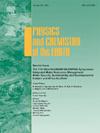Spatiotemporal variability and source attribution of PM2.5/PM10 ratios: Aerosol type classification and AQI evaluation across seventy monitoring stations in Delhi and Haryana, India
IF 3
3区 地球科学
Q2 GEOSCIENCES, MULTIDISCIPLINARY
引用次数: 0
Abstract
The present study examines PM2.5 and PM10 levels at 70 CAAQMS stations across Delhi and Haryana from 2020 to 2023. The aerosol-type classifications were employed based on PM2.5/PM10 ratios, revealing a significant source of particulate matter. PM2.5 levels increased from 84.31 μg/m3 in 2020 to 154.64 μg/m3 in 2023, while PM10 rose from 171.12 μg/m3 to 268.46 μg/m3, both exceeding NAAQS limits and posing risks to human health and the environment. The lower concentration in 2020 was linked to reduced activities during the COVID-19 lockdowns. Chandni Chowk had the highest PM2.5 levels in 2020, but by 2023, New Moti Bagh had become the most polluted. For PM10, Chandni Chowk recorded the highest concentration in 2020 and 2021, while Anand Vihar surpassed it in 2022 and 2023. Seasonal variation showed higher PM2.5/PM10 ratios in winter and post-monsoon, and lower ratios in the monsoon and pre-monsoon seasons due to climatic factors. Delhi has higher PM2.5/PM10 ratios than Haryana, likely due to greater vehicular density and industrial activity. PM2.5/PM10 ratio analysis reveals that mixed-anthropogenic type (IIb1) and mixed dust type (IIb2) dominate the aerosols in Delhi and Haryana. The AQI results reveal that PM2.5 is the dominant pollutant in Delhi and Haryana across all seasons (2020–2023), with the highest values during winter, 220 and 179 days and in post-monsoon, 280 and 302 days, respectively. The study emphasises the need for stricter emission controls, particularly in Delhi, and aligns with SDG 11, supporting urgent policies to combat air pollution and protect community health and the environment.
PM2.5/PM10比值的时空变异和来源归因:印度德里和哈里亚纳邦70个监测站的气溶胶类型分类和AQI评价
本研究调查了2020年至2023年德里和哈里亚纳邦70个CAAQMS站点的PM2.5和PM10水平。气溶胶类型分类基于PM2.5/PM10比率,揭示了颗粒物物质的重要来源。PM2.5浓度从2020年的84.31 μg/m3上升到2023年的154.64 μg/m3, PM10浓度从171.12 μg/m3上升到268.46 μg/m3,均超过国家空气质量标准,对人体健康和环境构成威胁。2020年的低浓度与COVID-19封锁期间活动减少有关。Chandni Chowk在2020年的PM2.5水平最高,但到2023年,新莫提巴格成为污染最严重的地区。对于PM10, Chandni Chowk在2020年和2021年的浓度最高,而Anand Vihar在2022年和2023年超过了它。受气候因素影响,PM2.5/PM10比值在冬季和季风后较高,在季风和季风前较低。德里的PM2.5/PM10比哈里亚纳邦高,可能是由于更大的车辆密度和工业活动。PM2.5/PM10比值分析表明,德里和哈里亚纳邦的气溶胶主要为混合人为型(IIb1)和混合粉尘型(IIb2)。AQI结果显示,PM2.5是德里和哈里亚纳邦所有季节(2020-2023年)的主要污染物,冬季和季风后分别在220天和179天和280天和302天达到最高值。该研究强调需要更严格的排放控制,特别是在德里,并与可持续发展目标11保持一致,支持应对空气污染、保护社区健康和环境的紧急政策。
本文章由计算机程序翻译,如有差异,请以英文原文为准。
求助全文
约1分钟内获得全文
求助全文
来源期刊

Physics and Chemistry of the Earth
地学-地球科学综合
CiteScore
5.40
自引率
2.70%
发文量
176
审稿时长
31.6 weeks
期刊介绍:
Physics and Chemistry of the Earth is an international interdisciplinary journal for the rapid publication of collections of refereed communications in separate thematic issues, either stemming from scientific meetings, or, especially compiled for the occasion. There is no restriction on the length of articles published in the journal. Physics and Chemistry of the Earth incorporates the separate Parts A, B and C which existed until the end of 2001.
Please note: the Editors are unable to consider submissions that are not invited or linked to a thematic issue. Please do not submit unsolicited papers.
The journal covers the following subject areas:
-Solid Earth and Geodesy:
(geology, geochemistry, tectonophysics, seismology, volcanology, palaeomagnetism and rock magnetism, electromagnetism and potential fields, marine and environmental geosciences as well as geodesy).
-Hydrology, Oceans and Atmosphere:
(hydrology and water resources research, engineering and management, oceanography and oceanic chemistry, shelf, sea, lake and river sciences, meteorology and atmospheric sciences incl. chemistry as well as climatology and glaciology).
-Solar-Terrestrial and Planetary Science:
(solar, heliospheric and solar-planetary sciences, geology, geophysics and atmospheric sciences of planets, satellites and small bodies as well as cosmochemistry and exobiology).
 求助内容:
求助内容: 应助结果提醒方式:
应助结果提醒方式:


